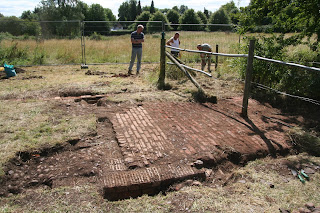From now on there
will be a small Friends work party on the third Thursday in the month unless
otherwise advised. Today’s task was to make a start on the management of the
spring area in the south part of the Park. Friends have been given
responsibility to manage and improve this small area and the task today was to
make a start on the autumn conservation cut to remove the overburden of summer
vegetation. If this is not done there will be an accumulation of a dense mat of material which will prevent
the germination of small seeds and more interesting plants. It will also
control the growth of shrubs which will change the nature of the area away from
that which is desired. The aim is to admit air and sunlight to promote a good
variety of wildlife. The material was cut using a hand scythe and raked off and
piled to make a composting heap for reptiles such as Grass Snakes.
Thursday, 19 September 2013
Big Dig Surprise.
Wednesday, 19 June 2013
Reptile refugia.
East Herts have provided a quantity of small rectangular
shaped pieces of black corrugated roofing material called refugia. 36 of these
have been placed in sunny positions throughout the Park. Not only do they
provide a refuge for reptiles but also a warm place where they can bask in the
sun.
Maintaining reptile habitat.
During February a small group of friends cut back bramble
which was threatening to overwhelm
Common Lizard site on the west of the Park. This has paid dividends as
Common Lizards have been seen basking in the recent warm weather.
Tuesday, 18 June 2013
Ancient Hornbeam.
During February 2012 and ancient Hornbeam in the north-west
corner of the park was felled because it was felt it was a safety hazard. This
was very unfortunate as it was probably one of the oldest trees on the Park.
The tree had been coppiced and as such probably predated the existence of the
Park, the tree would have been taken into the Park when it was formed which
means that it was growing in these 1700s. The tree had three main stems and was
very large.
Because the tree had been brutally felled without knowledge
of its historic importance, East Herts agreed to construct a barrier around it
to prevent damage by browsing animals and to give it every chance, however
slight of recovery.
Mercifully, and against all the odds, there happened to be
some small shoots on the north side of the stump. Friends have added some
chicken wire to prevent rabbits gaining access and to date these small shoots
are growing well so we shall keep our fingers crossed.
Big Dig 2012
During August 2012 a series of 1 m square test pits were dug
over the site of an old building on the Park. The Friends were ably assisted in
this task by local archaeologists Caroline Baigent and Wally Wright.
Over the two days we dug up a lot of building materials, pottery and bone.
On the afternoon of the second day we uncovered
a cobbled courtyard and a brick set floor.
There appears to have been a thick layer of gravel laid over
the area probably to help with the drainage.
Currently, we do not know the use for the yard and floor.
The Tithe Map gives the area as "cattle sheds".
It is possible that the small building may be a milking
shed. Hopefully, they excavation to be carried out in 2013 will help further
with the explanation.
Subscribe to:
Comments (Atom)




























